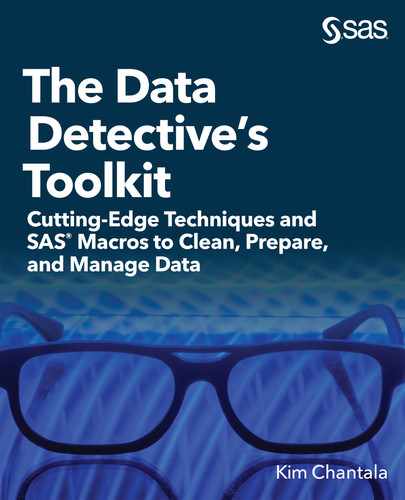What Does This Book Cover?
Data professionals who survived deep cuts in funding during the financial crisis of 2007–2008 had to develop innovative methods of data preparation. This book presents innovative data tools and techniques that helped data managers, practitioners, and programmers survive these challenges by reducing the cost and time needed for data management while improving the quality of data prepared with their use. These tools include SAS macros as well as ingenious ways of using SAS procedures and functions.
Is This Book for You?
This book is designed to help automate many of the tasks performed to turn raw data into analysis-friendly data. These tasks are often filled with a mix of irksome and strenuous activities that stand between you and data that can be used. This book will help preparers of the data in different ways:
|
Intermediate and |
You will reduce your workload and improve the quality of your data by using the SAS macro programs included with this book to automate error-checking and create documentation for your project data. Using these programs included with this book will alleviate the tedious nature of data preparation by automating the identification of inconsistencies and anomalies in raw data. |
|
Novice users: |
If you are not familiar with SAS and are just starting to work with data, you will need to get help from a more experienced programmer to use the SAS macro programs that automatically produce codebooks, reports highlighting problems in the data, inventories of available data sets, and crosswalks showing commonalities of multiple data sets. These are covered in Chapters 3 through 6. Once the SAS statements are set up to run the SAS programs producing these reports, you will find it easy to assist in the detective work of data preparation. Examining these reports will really help you get to know your data, and you can help to solve problems identified in the data. Focusing on the discussion of the output in examples of this book will help you learn to interpret these reports and lead to a better understanding of your data. Skip the sections in each chapter titled “Inside the Toolkit” that discuss the macro program statements in detail. |
|
Data managers and |
You will be able to choose from the many automated reports that function as roadmaps into your data, snapshots of data quality and monitoring, and use these reports to improve communication between your programmer, practitioners, and the data collection sponsors. |
|
All users: |
No matter what your level of experience, you should read Chapter 1, “Advantages of Using the Data Detective’s Toolkit” and Appendix A, “Your Part in the Data Life Cycle.” |
What Are the Prerequisites for This Book?
Familiarity with SAS programming (the DATA step and basic rules of the SAS language) as well as manipulating SAS data with procedures such as PROC CONTENTS, PROC MEANS, and PROC FREQ provide adequate prerequisites for working with the SAS programs and techniques discussed in this book. Familiarity with basic features of the SAS macro language would be useful to run the SAS macro programs that accompany this book. For programmers new to the SAS macro language, detailed instruction is provided in Chapter 2 with information about using SAS.
What Should You Know about the Examples?
Software Used to Develop the Book’s Content
The output in this book was created with SAS 9.4. Most programs in this book can be run using BASE SAS on the platform that you typically use. A few of the examples use procedures found in the SAS/STAT software.
Example Code and Data
All data used in the examples in this book was simulated. Any resemblance to actual data sets is purely coincidental. Errors and other anomalies were purposely added to the data to illustrate special features described in this book to clean, prepare, and perform quality control checks on your data.
You can access the example code and data for this book by linking to its author page at https://support.sas.com/chantala.
Output and Graphics
All output in this book was created with the SAS Output Delivery System. Your output might look slightly different because changes in the appearance of some tables have occurred during the formatting of this book.
We Want to Hear from You
SAS Press books are written by SAS Users for SAS Users. We welcome your participation in their development and your feedback on SAS Press books that you are using. Please visit sas.com/books to do the following:
● Sign up to review a book
● Recommend a topic
● Request information about how to become a SAS Press author
● Provide feedback on a book
Do you have questions about a SAS Press book that you are reading? Contact the author through [email protected] or https://support.sas.com/author_feedback.
SAS has many resources to help you find answers and expand your knowledge. If you need additional help, see our list of resources: sas.com/books.
Learn more about this author by visiting her author page at http://support.sas.com/chantala. There you can download free book excerpts, access example code and data, read the latest reviews, get updates, and more.
